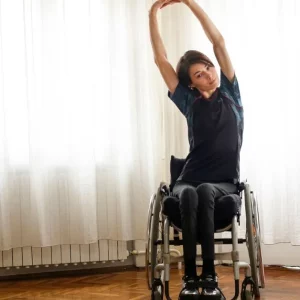While slight fluctuations in body temperature throughout the day are normal, a spinal cord injury (SCI) may prevent areas below the level of injury from cooling off or warming up as it typically would.
Signals between the brain and areas innervated below the level of injury may not be able to get past the site of injury. As a result, individuals may lose sensation below their level of injury, which can make it difficult for your brain to understand when the body is too cold or warm. Your body’s ability to regulate temperature is known as thermoregulation.
This article will explain how spinal cord injury (SCI) can affect thermoregulation and what you can do to better manage your body temperature.
How Does Spinal Cord Injury Affect Body Temperature Regulation?
Normally, your body produces sweat to cool down. Conversely, you’ll get goosebumps and start shivering to conserve heat and warm up. However, after a spinal cord injury, areas below the level of injury may not be able to regulate body temperature like they did prior to the injury.
Messages between the brain and areas below the level of injury may have trouble getting past the site of injury. As a result, the brain may not receive sensory input from the areas below your level of injury and will struggle to send the necessary commands to regulate body temperature.
The hypothalamus plays a large role in thermoregulation by controlling body temperature. Hot and cold signals travel to the hypothalamus, which uses the information to activate or inhibit the sympathetic nervous system.
The sympathetic nervous system is responsible for controlling your fight-or-flight response. When activated, it will accelerate heart rate, increase blood flow, and trigger the adrenal glands to produce sweat to regulate body temperature.
Up next, we’ll discuss various factors that can affect body temperature following spinal cord injury.
Factors that Affect Body Temperature After Spinal Cord Injury
Inability to properly regulate body temperature after spinal cord injury will result in hypothermia (a dangerously low body temperature below 95˚F) or hyperthermia (overheating).
Because individuals with SCI are more susceptible to problems with regulating body temperature, it’s essential to understand how everyday factors can contribute to a rise or decline in body temperature.
Below, we’ll go over 8 factors that affect body temperature after spinal cord injury.
1) Level of Injury
Generally, the higher your level of injury, the greater the risk of experiencing difficulties with body temperature regulation. Level of injury refers to the bottommost segment of the spinal cord where normal sensation and motor control exist.
Those with T6 or higher level spinal cord injuries are generally more sensitive to fluctuations in body temperature and may experience autonomic dysreflexia.
Autonomic dysreflexia describes a reflexive spike in autonomic functions such as blood pressure, feelings of panic, and body temperature due to stimulation below your level of injury. Common causes of autonomic dysreflexia include a full bladder, wearing clothes that are too tight, and extreme temperatures.
2) Severity of Injury
Generally, the more severe a spinal cord injury is, the greater the risk of impaired thermoregulation.
For example, individuals with complete SCIs lack movement or feeling below their level of injury because the neural connections between the brain and body have been damaged. As a result, the hypothalamus is unable to receive sensory input and, therefore, cannot regulate temperatures below the level of injury.
Individuals with incomplete spinal cord injuries may have some thermoregulation below their level of injury due to the spared neural pathways in the spinal cord.
3) Blood Flow
Another way the body regulates temperature is through the tightening and expanding of the blood vessels.
When the body overheats, vasodilation occurs. Vasodilation describes the expansion of blood vessels. This creates more room for the heat in your blood to disperse, which helps cool the body down.
In contrast, when your body becomes cold, the blood vessels will undergo vasoconstriction and tighten. This increases blood flow near the center of the body to conserve warmth.
4) Environment
The temperature of the surrounding environment can drastically affect your body temperature. When possible, individuals with impaired body temperature regulation after spinal cord injury should try to avoid extreme temperatures.
In instances where extreme temperatures cannot be avoided, individuals should be prepared to manually warm themselves up or cool down. Methods for doing so will be discussed later in this article.
5) Emotional State
When you’re riled up or panicked, a release of stress hormones activates your sympathetic nervous system. This causes your heart rate and blood pressure to rise, which increases your overall body temperature.
Increased body temperature due to emotional or psychological factors is called psychogenic fever. This rise in temperature is typically brief and resolves on its own.
6) Exercise
Individuals with spinal cord injuries may not be able to maintain a safe body temperature when participating in intense exercise. Because you might not be able to sweat, you have a greater risk of overheating.
While individuals with spinal cord injuries need to regularly move their bodies, strenuous exercise may not be ideal. Consult with your doctor or physical therapist to determine which types of exercises are beneficial for your specific spinal cord injury.
Want 15 pages of SCI recovery exercises in PDF form? Click here to download our free SCI Rehab Exercise ebook now (link opens a pop up for uninterrupted reading)
7) Skin Thickness
Your skin protects your body from the outside environment and plays a significant role in body temperature regulation. Sweat glands located in the skin contribute to thermoregulation by cooling the body, whereas sebaceous glands help retain moisture. The skin also stores fat, which insulates heat to keep you warm.
8) Muscle Mass
Limited mobility after a spinal cord injury generally results in reduced movement throughout the day. Consequently, the muscles shrink to conserve energy.
Everyday movement and weight-bearing help maintain muscle mass and promote blood circulation. In fact, 85% of heat production is generated through muscle contractions. This is why you shiver when you’re cold. It is the body’s way of warming you up through quick muscle contractions.
In the long run, reduced muscle mass and physical inactivity can slow down your metabolic rate, which limits the body’s ability to produce heat.
Now that you understand various factors that can contribute to changes in body temperature after a spinal cord injury, let’s discuss ways to manually regulate body temperature.
Managing Spinal Cord Injury and Body Temperature
After spinal cord injury, the best way to manage body temperature is to be aware of your surroundings and be prepared.
Below, we’ll discuss helpful tips for manually cooling down and warming up.
What to Do When Body Temperature is High
When your temperature rises, you may experience flushed skin, headaches, dizziness, or weakness.
Effective ways to cool the body down include:
- drinking water throughout the day
- carrying a spray bottle and wet cloth/towel
- wearing lighter clothing
- moving to a cooler environment
- sitting in front of a fan
Due to lack of sensation, individuals should avoid using ice packs as they can cause ice burn when left on the skin for too long.
What to Do When Body Temperature is Low
When your body temperature is low, you may experience shivering, slow breathing, pale skin color, slurred speech, and a weak pulse.
To warm the body up, try:
- wearing more layers
- taking a warm bath
- drinking a warm beverage
- using an electric blanket to warm up quickly (but be time-conscious and lower the temperature after a while to avoid overheating)
- moving to a warmer location
- exercising (individuals with extensive paralysis should practice passive range of motion exercises with their caregiver to stimulate blood flow)
The outcomes of every spinal cord injury are unique and some people will struggle with body temperature regulation more than others. Consult with your doctor to determine ideal management interventions for your specific spinal cord injury.
Body Temperature Regulation After Spinal Cord Injury
After a spinal cord injury, individuals may struggle with body temperature regulation below their level of injury. A variety of factors can contribute to fluctuations in body temperature, so it’s essential to understand potential triggers and be prepared.
Hopefully, this article helped you better understand the link between spinal cord injury and body temperature.











